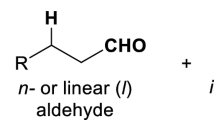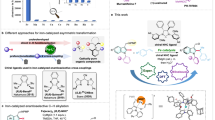Summary
A new stationary phase for gas chromatography, dimeric rhodium (II) benzoate, was found to interact rapidly and reversibly with sigma donor molecules such as ethers, ketones and esters, thereby considerably increasing their retention volumes. In addition, interaction and separation of olefins has been achieved with the same phase. The specific interaction of olefins with the rhodium (II) complex is particularly interesting since the relative retention increase is quite different than that for rhodium (I) and silver (I). Furthermore, an “inverse” steric effect is observed as the interaction of olefins increases with increasing alkyl substitution at the double bond. The mechanism of interaction involved and the analytical applications are briefly discussed.
Zusammenfassung
Es wurde gefunden, daß eine neue stationäre Phase für die Gas-Chromatographie, nämlich dimeres Rhodium (II) Benzoat, schnell und reversibel mit Sigma-Donatoren-Molekülen wie Äther, Ketone und Ester in Wechselwirkung tritt, wodurch deren Retentionsvolumina beträchtlich erhöht wurden. Zusätzlich wurde eine Wechselwirkung und Trennung von Olefinen mit derselben Phase erreicht. Die spezifische Wechselwirkung von Olefinen mit dem Rhodium (II)-Komplex ist besonders interessant, da der relative Retentionszuwachs sich merklich von dem für Rhodium (I) und für Silber (I) unterscheidet. Weiterhin wird ein „umgekehrter” sterischer Effekt beobachtet, da die Wechselwirkung bei den Olefinen mit steigender Alkyl-Substitution an der Doppelbindung ansteigt. Der in Frage kommende Wechselwirkungs-Mechanismus und die analytischen Anwendungsmöglichkeiten werden kurz diskurtiert.
Résumé
On a trouvé une nouvelle phase fixe pour la chromatographie en phase gazeuse: le benzoate de rhodium (II) qui réagit rapidement et réversiblement avec des molécules de donneurs du type sigma, telles que les éthers, les cétones, et les esters et augmente ainsi considérablement leurs volumes de rétention. En outre, la réaction et la séparation des oléfines a été obtenue avec la même phase fixe. L'interaction spécifique des oléfines avec le sel de rhodium (II) est d'un intérêt tout particulier puisque l'augmentation relative de la rétention est tout à fait différente de celle que l'on constate pour le rhodium (I) et l'argent (I). D'autre part, un effet stérique «inverse» a été observé, puisque l'interaction des oléfines avec la phase fixe augmente avec le nombre de groupes alkyles substituants au voisinage de la double liaison. Le mécanisme de l'interaction étudiée, ainsi que les applications analytiques possibles, sont discutés brièvement.
Similar content being viewed by others
Literature
G. P. Cartoni, R. S. Lowrie, C. S. G. Phillips, andL. M. Venanz, “Gas Chromatography 1960”,R. P. W. Scott, Ed., Butterworth Scientific Publications, London, 1960, p. 273.
G. P. Cartoni, A. Liberti, andR. Palombari, J. Chromatog.20, 278 (1965).
B. Feibush, R. E. Sievers, andC. S. Springer, Jr., 158th National Meeting of the Chemical Society, New York, N. Y., September, 1969, No. INOR 66;B. Feibush, M. F. R. Richardson, R. E. Sievers, andC. S. Springer, Jr., submitted for publication.
B. W. Bradford, D. Harvey, andD. E. Chalkley, J. Inst. Petrol., London,41, 80 (1955).
A. Zlatkis, andI. M. R. de Andrade, Chromatographia2, 298 (1969) and references quoted therein.
V. Schurig, andE. Gil-Av, Chem. Commun., 1971, 650.
E. Gil-Av, andV. Schurig, Anal. Chem.43, 2030 (1971).
M. A. Muhs, andF. T. Weiss, J. Amer. Chem. Soc.,84, 4697 (1962).
E. Gil-Av, andJ. Herling, J. Phys. Chem.,66, 1208 (1962).
R. J. Cvetamovic, F. J. Duncan, W. E. Falconer, andR. S. Irwin, J. Amer. Chem. Soc.,87, 1827 (1965).
J. Kitchens, andJ. L. Bear, Thermochimica Acta1, 537 (1970).
M. A. Porai-Koshits, andA. S. Antsyshkina, Dokl. Akad. Nauk. SSSR,146, 1102 (1962).
M. J. Bennett, K. G. Caulton, andF. A. Cotton, Inorg. Chem.8, 1 (1969) and references cited therein.
S. A. Johnson, H. R. Hunt, andH. M. Neumann, Inorg. Chem.2, 960 (1963).
J. Kitchens, andJ. L. Bear, J. Inorg. Nucl. Chem.31, 2415 (1969).
G. Winkhaus, andP. Ziegler, Z. Anorg. Allgem. Chem.,350, 51 (1967).
Author information
Authors and Affiliations
Rights and permissions
About this article
Cite this article
Schurig, V., Bear, J.L. & Zlatkis, A. Rhodium (II) carboxylates as new selective stationary phases in gas-liquid chromatography. Chromatographia 5, 301–304 (1972). https://doi.org/10.1007/BF02310747
Received:
Accepted:
Issue Date:
DOI: https://doi.org/10.1007/BF02310747




